 |
 |
| Sometimes reality is more wonderful than fiction |
 |
| Cave temple near the village of Stinka Photos of Alena Krushinskii. 2004 p. |
| A natural cave is located on a left steep bank of the Dniester River at height of 40 ft. Obviously, it has been adapted after simple processing for the sanctuary even in pagan times, and converted into a Christian church later. Pagan and Christian signs carved on the walls could be seen until recently. There were in the cave also complexes of characters that can be a text of unknown writing. All characters are distorted by time, and later by modern graffiti, so their copies made by different persons is slightly different in detail. However, they have a certain historical value, since the inscription is no longer possible to make out in recent years. There are on the southern and northern walls of the entrance signs of crosses. The grotto has a trapezoidal shape in plan with walls of 25 ft in length, a width of 30 ft, a height of 12 ft. A chancel with two porches can be seen in the middle of the cave. An image of solar sign in the form of a swastika was carved in the central part of the altar. Diameter of the image is 30 cm, its vertical element has bifurcated ends and the horizontal one is bent on one side up, on the other down. |
 |
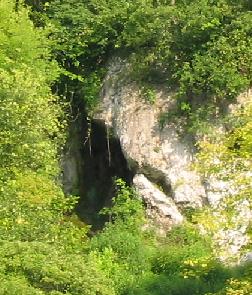 |
| On the north wall of the altar, tamga-shaped mark can be seen as a rectangle intersected by cross line; on the south wall of the temple there is a stylized relief image of a leaping animal, and the inscription consisting of six tamga-shaped characters scraped out on the west wall. The first and fourth characters resemble the number 4. The second and fifth are in the form a loop with one end which is rounded, and the other is bent at an angle. |
| The entrance to the grotto. Photo W. Backus. |
| Above: The sign on the wall. Right: A group of researchers came to the cave. Photo W. Backus. |
| The third character has shape of scratches narrowed down as an angle, and the sixth resembles the Cyrillic letter N. Two visible signs, reminiscent of the Greek kappa and omega are below the inscription. At the entrance to the temple were found fragments of ancient pottery. The relic can be classified as common for the 11th - 12th cen AD category of churches. The closest to it is the famous temple near Mizhgirya in Ternopil Region. The tamga-shaped signs are similar ones of the Northern Pontic Country. The inscriptions on walls are known in Christian churches, particularly in the St. Sophia Cathedral in Kiev. An image of leaping cheetah is present in St. Michael's Cathedral. |
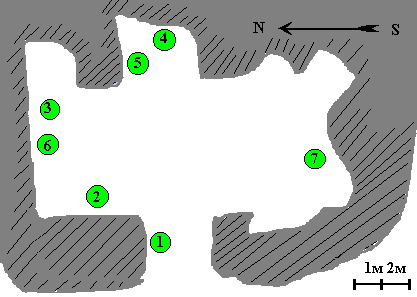 |
 |
 |
| Plan of the grotto made by Boris Ivankov. The numbers indicate the signs shown cast below. Right: The interior of the cave. Figure of A. Kwiatkowski. |
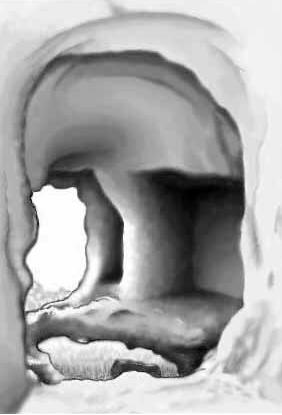 |
| The photos show the sketched earlier signs in its natural state as of 2004. Fight: Part of the left wall of the temple, where you can see if you want an engraved cross. |
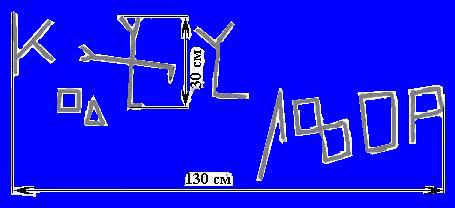 |
| The pictures on the walls of caves in sketches of members of the expedition "Dnister" (1989 - 2004) |
 |
 |
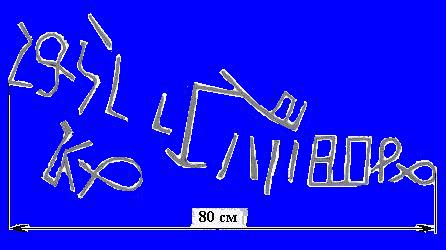 |
 |
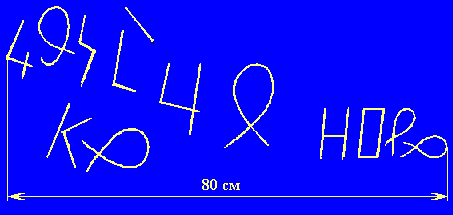 |
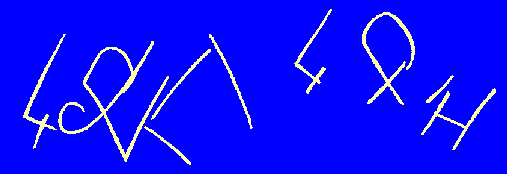 |
| Above: The inscription on the wall, copied by Boris Ivankov in 1989 (see a copy of the same inscription of Andrew Kwiatkowski left). Certain signs like the runic of ancient Turks, in particular, as the Orkhon-Yenisey, and the Ancient Chuvash (see table below) |
 |
| Orkhon-Yenisey signs were deciphered by the Danish scientist B. Thomsen. Ancient Chuvash runic alphabet was studied by A. Trofimov. Online " Cultural heritage of Chuvashia" gives table of Ancient Chuvash runes (see above) Left: table runic signs, made according to the Bulgarian investigator P. Dobrev, who has studied the runic inscriptions of Murfatlar village in Northern Dobrudja, on the walls of the first Bulgarian capital Pliska, and elsewhere. His proposed transcript based on the assumption of Iranian language of ancient Bulgars, therefore is wrong, but majority given by him signs belong Bulgars (some characters clearly Cyrillic). |
| Another set of Ancient Chuvash runes gives without specifying the source site " The country of one hundred thousand songs" of Sverdlovsk regional ethnic library. For each of the characters, you can find a match or in Orkhon-Yenisei signs or in the tables of Trofimov and Dobrev. The similarity of characters from the cave Stinka to some runes gives warrant to conclude that the inscription in the cave were left by the ancient Bulgars. (For ease of comparison, these characters are numbered and placed in red frames). Matches to marks Nos. 10, 11, 12 can be found in the tables Trofimov and Dobrev. The sign at number 13, as mentioned above, was also carved separately. Apparently it had some sacral meaning. We can assume that the in some way invested cave was originally used as a pagan shrine, and later, according to the left symbolism, as a Christian church. |
 |
| And now we will try to decipher the inscription on the central altar of the temple, which is reconstructed from the made sketches. Its foreseen is shown on the left. We see that the first two characters are similar to the last two ones. If the inscription was made by the Bulgarish language, then according to the law of open syllable, the second and final signs shall be vowels if the word begins with a consonant, what is most likely (in the Chuvash language overwhelming number of words begin with a consonant). |
| The first sign in the shape of Ч is identical to the character referring to the sound d in Dobrev's table. In the modern Chuvash language, close to that sound is reflected by the letter t (letters for the sound d are absent). Then the inscription in the modern Chuvash writing would have the form t8??t8, where 8 – any vowel sound, and the remaining two other sounds remain in question. It was nothing better found in the dictionary of Chuvash language [SKVORTSOV M.I. (Ed.) 1985] as stable word combination tupatu "to take an oath". This inscription is very suitable for the altar. The custom "tupa tu" to oath of loyalty before marriage is kept among Chuvash till now. Obviously the temple was devoted to the Scythian chaste goddess Tabiti (see Scythian Mytology) Thus, an additional evidence of the stay of ancient Bulgar (Scythians) in Western Ukraine is found. |
|